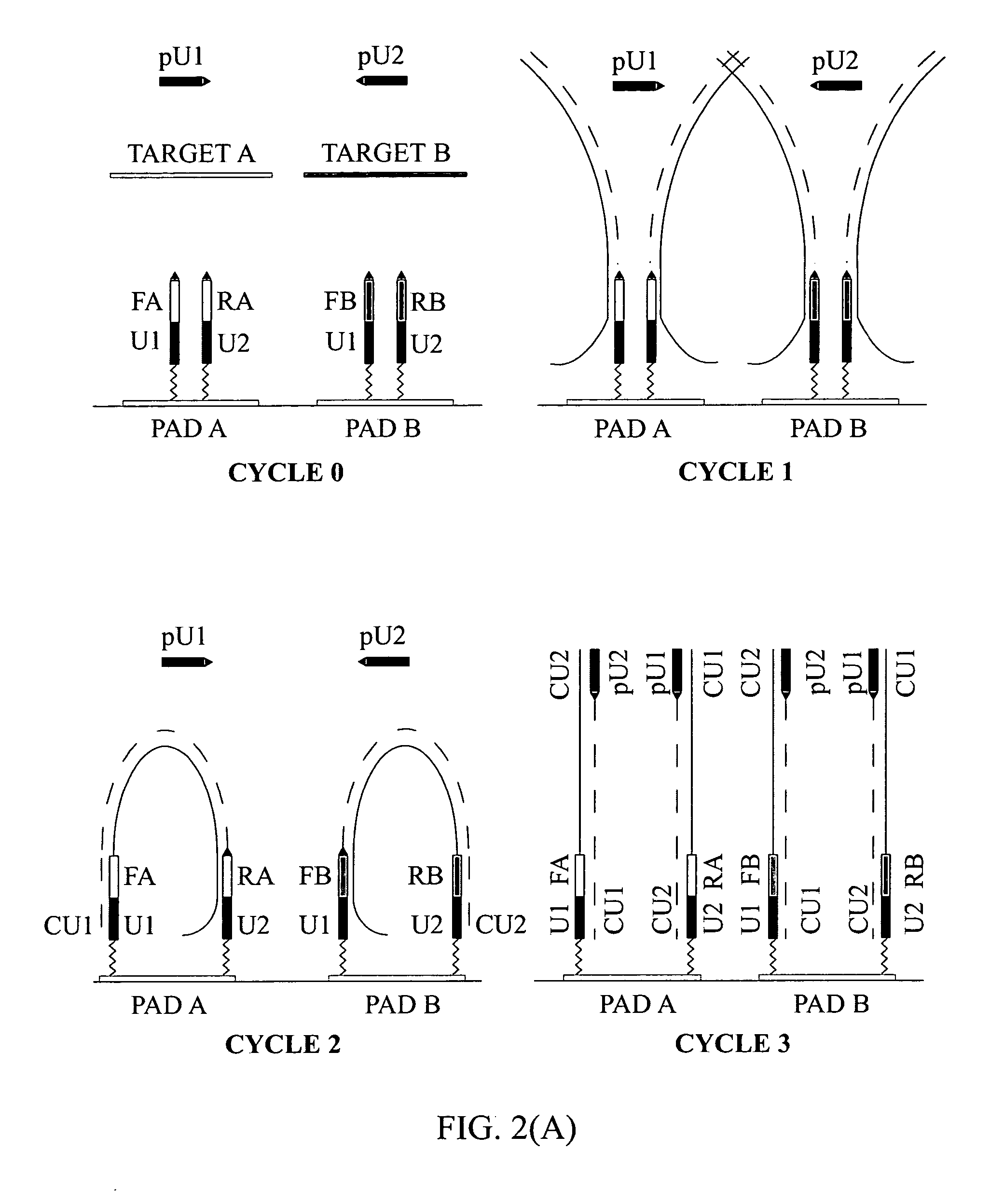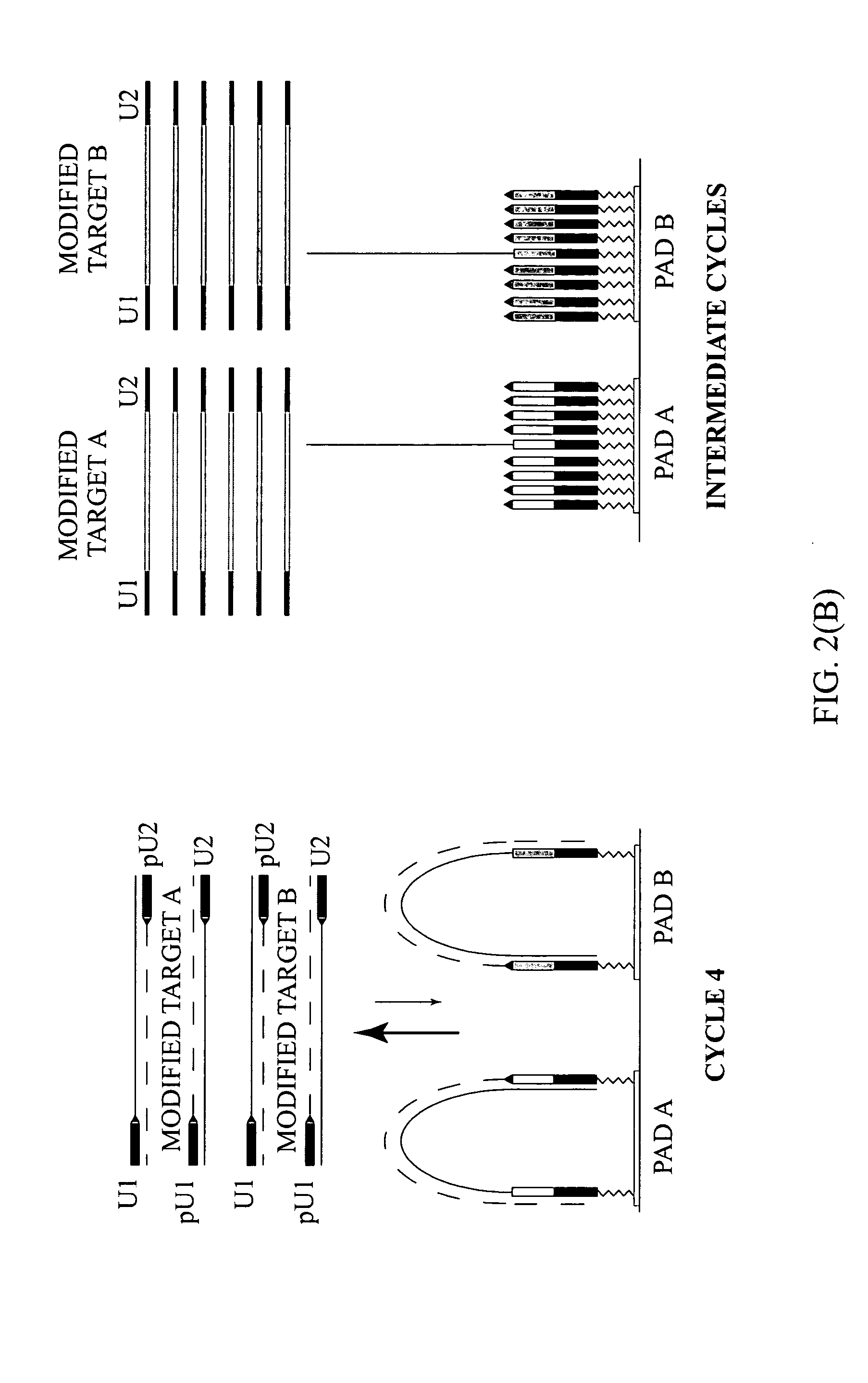Dual phase multiplex polymerase chain reaction
a polymerase chain reaction and multiplex technology, applied in the field of dual phase multiplex polymerase chain reaction, can solve the problems of low sensitivity of the method, the inability to perform pcr reactions on solid supports such as biochips or microbeads, and the inability to achieve the same degree of sensitiveness as conventional pcr, etc., to achieve the effect of increasing the reaction volum
- Summary
- Abstract
- Description
- Claims
- Application Information
AI Technical Summary
Benefits of technology
Problems solved by technology
Method used
Image
Examples
example 1
PCR in Test Tubes with Complex and Universal Primers
[0126] Ability of two types of primers, complex and universal, to support conventional PCR in tubes was tested. FIG. 4 illustrates a conventional PCR with complex and universal primers. Two pairs of complex primers, denoted A and B, and a single pair of universal primers, pU1 and pU2, were used in conventional PCR.
[0127] (A) Reaction without universal primers: Complex primers A and B were taken at increasing amounts: 0.5, 2.0, 5.0, 10.0 and 20.0 pmol of each per 25 μL of the reaction mix.
[0128] (B) Reaction with complex primers A and B, taken at concentrations as in FIG. 4(A), and pU1 and pU2 universal primers taken at concentration 20 pmol of each per 25 μL of the reaction mix is shown.
[0129] Lanes 2, 4, 6, 8 and 10 contain PCR products generated by primer pair A, and lanes 3, 5, 7, 9 and 11 contain PCR products generated by primer pair B. Lanes 1 and 12 with 100 bp DNA marker are denoted as M. Numbers above the lanes denote a...
example 2
Dual-Phase PCR Proceeds Through the Formation of Modified Targets
[0131] To demonstrate the presence of modified targets in the reaction mix upon the completion of the reaction content of PCR mixture in the reaction chamber was analyzed. FIG. 5 illustrates that dual-phase PCR reaction proceeds through synthesis of modified targets.
[0132] (A) Microarrays were manufactured by immobilizing complex primers U1-Fa and U2-Ra (see Table 1) to a standard array of gel pads. A suitable support such as a 2-dimensional (2D) surface or a 3-dimensional (3D) matrix, including glass slides, microbeads, microcanals, gel pads, membranes, metal, plastic and any suitable matrix can be used in the fabrication of microarrays. On the chromosomal map of Bacillus mycoides, the distance between the 5′ends of the specific segments of the complex primers -Fa and -Ra was 165 bp, the combined length of the universal segments -U1 and -U2 is 40 bp, and therefore, the calculated size of the modified target in this ...
example 3
Universal Primers Dramatically Increase Efficiency of On-Chip PCR
[0136] Addition of the universal primers into the reaction mix affects the efficiency of the on-chip PCR. The absence of universal primers in the reaction mix prevents the synthesis of modified products, and therefore, affects the yield of the PCR.
[0137]FIG. 6 illustrates on-chip PCR with or without universal primers. Microarrays were manufactured by immobilizing complex primers U1-Fa and U2-Ra (see Table 1) to a standard array of gel pads. PCR on microarrays was performed either with or without the addition of universal primers pU1 and pU2 into a reaction mix. After PCR, the microarrays were hybridized with a reporting probe labeled with a fluorescent dye. In addition to various fluorescent dyes, a reporting probe can be labeled with all suitable detecting compounds such as radioactive isotopes, gold particles, light scattering particles, energy transferring compounds, luminescent dyes, ligands such as biotin, etc. ...
PUM
| Property | Measurement | Unit |
|---|---|---|
| Mass | aaaaa | aaaaa |
| Fluorescence | aaaaa | aaaaa |
Abstract
Description
Claims
Application Information
 Login to View More
Login to View More - R&D
- Intellectual Property
- Life Sciences
- Materials
- Tech Scout
- Unparalleled Data Quality
- Higher Quality Content
- 60% Fewer Hallucinations
Browse by: Latest US Patents, China's latest patents, Technical Efficacy Thesaurus, Application Domain, Technology Topic, Popular Technical Reports.
© 2025 PatSnap. All rights reserved.Legal|Privacy policy|Modern Slavery Act Transparency Statement|Sitemap|About US| Contact US: help@patsnap.com



